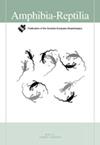草原响尾蛇(Crotalus viridis)的觅食和食腐行为:没有证据表明毒液线索有助于猎物的偷窃寄生
IF 1.3
4区 生物学
Q3 ZOOLOGY
引用次数: 0
摘要
大多数毒蛇是埋伏捕食者,主要使用毒液来制服猎物,采用一种攻击-释放-追踪狩猎策略,即蛇根据有毒猎物的独特气味来定位它们咬过并释放的尸体。除了杀死猎物,响尾蛇(像大多数食肉动物一样)也会机会主义地吃腐肉。这种食腐策略可能包括偶尔食用被其他蛇杀死的尸体(即偷窃寄生)。在其他蛇密度很高的地区,利用被其他蛇中毒的动物的独特气味可能是一种可行的替代觅食策略。我们通过一系列圈养草原响尾蛇(Crotalus viridis)的行为实验来评估这种可能性,以确定同种或异种(C. scutulatus, C. ornatus)的毒素提示是否会增加盗窃寄生虫的可能性。响尾蛇不喜欢有毒液的猎物而不喜欢没有毒液的猎物,也不喜欢一个物种的毒液线索而不喜欢另一个物种。虽然它们确实经常清理尸体,但在没有攻击的情况下,蛇通常使用随机搜索动作而不是气味痕迹来定位尸体。此外,响尾蛇花在调查尸体踪迹上的时间在不同的处理方法中并没有显著差异,这表明,在追踪行为中,撞击以及由此形成的猎物化学搜索图像比毒液线索更重要。此外,观察到个体之间存在高度的行为差异,这表明响尾蛇的食腐和偷窃寄生行为比以前认识到的要复杂得多,并且对这些行为进行概括是具有挑战性的。本文章由计算机程序翻译,如有差异,请以英文原文为准。
Foraging and scavenging behaviour of the prairie rattlesnake (Crotalus viridis): no evidence that envenomation cues facilitate kleptoparasitism of struck prey
Most viperids are ambush predators that primarily use venom to subdue prey, employing a strike-release-trail hunting strategy whereby snakes follow the unique scent of envenomated prey to locate carcasses they have bitten and released. In addition to killing prey, rattlesnakes (like most carnivores) will also opportunistically scavenge carrion. This scavenging strategy likely includes the occasional consumption of carcasses killed by other snakes (i.e., kleptoparasitism). In areas with high densities of other pitvipers, utilizing the unique scent of animals envenomated by other snakes might be a viable alternative foraging strategy. We evaluated this possibility experimentally using a series of captive behavioural trials on prairie rattlesnakes (Crotalus viridis) to determine whether conspecific or heterospecific (C. scutulatus, C. ornatus) envenomation cues might increase the likelihood of kleptoparasitism. Rattlesnakes did not prefer envenomated prey over nonenvenomated prey, nor did they prefer venom cues of one species over another. Although they did frequently scavenge carcasses, in the absence of striking, snakes generally located carcasses using random searching movements instead of scent trails. Additionally, the amount of time rattlesnakes spent investigating carcass trails did not differ significantly among treatments, suggesting that striking, and the resultant formation of a chemical search image of prey, is more crucial to trailing behaviour than venom cues. Moreover, a high degree of behavioural variation among individuals was observed, suggesting that scavenging and kleptoparasitism in rattlesnakes is more complex than previously realized, and making generalizations about these behaviours is challenging.
求助全文
通过发布文献求助,成功后即可免费获取论文全文。
去求助
来源期刊

Amphibia-Reptilia
生物-动物学
CiteScore
3.10
自引率
6.20%
发文量
39
审稿时长
6-12 weeks
期刊介绍:
Amphibia-Reptilia is a leading European multi-disciplinary journal devoted to most of the aspects of herpetology: ecology, behaviour, evolution, conservation, physiology, morphology, paleontology, genetics, and systematics.
Amphibia-Reptilia publishes high quality original papers, short-notes, reviews, book reviews and news of the Societas Europaea Herpetologica (SEH). The Societas Europaea Herpteologica (SEH) website is located at: www.seh-herpetology.org.
 求助内容:
求助内容: 应助结果提醒方式:
应助结果提醒方式:


